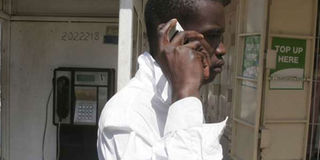Kenya well placed to benefit from market demand

A mobile phone user in Kisumu. Kenya has 31.8 million mobile phone users or an 88 per cent penetration rate. FILE PHOTO | NATION MEDIA GROUP
What you need to know:
- Mobile communication drives conversations, influences cultural change through social media and internet access.
- The tripartite common market is an enormous opportunity to enhance and boost intra-Africa bargaining power, trade and exchange.
Kenya is centrally positioned to take advantage of the steady growth of market demand and industrialisation across Africa.
The quick embrace of mobile telephony, financial technology, and most recently the bitcoin and the underlying blockchain technology, paints the picture of a region that’s receptive to technological change and transformation.
According to the 2017 Economic Report on Africa titled Urbanisation and Industrialisation for Africa’s Transformation, four out of 10 people on the continent currently live in cities and that number will rise to five out of 10 in about 18 years.
This means that by 2035 half of the continent’s population will be living in cities.
MOBILE PHONES
The rapid urbanisation, technology transfer, partnerships and industrialisation provide critical tools and infrastructure that could potentially grow Africa to build modern states within a generation.
One of the powerful tools in the hands of the African population is the fact that the number of mobile phone users will hit one billion by 2022.
Kenya has 31.8 million mobile phone users or an 88 per cent penetration rate.
Mobile communication drives conversations, influences cultural change through social media and internet access and aids mobile money transfers.
In the modern age, the medium has become the message and the need for speedy, reliable communication continues to grow.
DIGITAL COMMUNICATIONS
Digital media ecosystems have revolutionised how we interact, entertain, advertise, work, conduct business, gain knowledge, create, and communicate.
While we challenge for the growth of more digital development, infrastructure developments will facilitate flow of ideas more freely and collaborate partnerships on product innovations.
It has also launched new careers in the information technology, financial technology, and online marketing.
Most critically, digital communications have given a voice to gender diversity as well as political and ethnic minorities whose ingenuity, creativity, and sustenance has been suppressed.
Limited road network has significantly slowed down the pace of industrialisation in most sub-Saharan countries.
ELECTRICITY
Even so, transport infrastructure is not even the region’s most pressing problem, keeping the lights on is.
Outages and high-power bills as well as limited penetration of electricity has contributed to lower productivity.
According to a 2010 report by the World Bank and France’s development agency, as many as 30 countries have to endure frequent power outages.
While many firms in the region resort to expensive diesel generators, these aren’t sustainable and often push the operating costs upwards.
Meanwhile, artificial intelligence offers such incredible opportunity for progress thanks to the rapid development of technology, sophisticated algorithms, exponential increases in computing power, and the vast availability of data.
CONSUMERS
The Kenyan government has made an interesting move through the establishment of the blockchain committee on this revolutionary technology.
The tripartite common market is an enormous opportunity to enhance and boost intra-Africa bargaining power, trade and exchange.
With a population of about 700 million, mostly made up of vibrant and youthful population, the tripartite Free Trade Area (FTA) currently has a Gross Domestic Product of about USD$1.4 trillion, which could double by 2035.
The rise of the African consumer class, coupled with an increasingly interconnected market of 28 plus member country free trade zone, provides a new platform for the exchange of goods, services, cultures, knowledge and faster speeds.
MANUFACTURING SECTOR
My view is that the world is angling towards a global economy acting as agglomeration of several global villages.
The FTA was a futuristic and ambitious project launched about June 2015 to bring together, into one common market, the three African regional economic blocs – Comesa, EAC and SADC.
According to a draft budget policy statement on the Big Four Agenda that will define President Uhuru Kenyatta’s legacy, the government seeks to focus on manufacturing, universal healthcare, affordable housing, and food security.
The Kenyan government seeks to raise the share of the manufacturing sector from nine to 15 per cent of the gross domestic product by 2022, provide universal health coverage for all Kenyan households, expand food production and supply, and build 500,000 affordable houses.
These four ideas and other critical infrastructural initiatives — including the Standard Gauge Railway, the Lamu port, national health projects and Lapsset — may be well utilised if we review the high cost of power and make our goods and services more price competitive — further growing intra-Africa trade and providing employment.
Chris Diaz is a member of the Brand Kenya board




